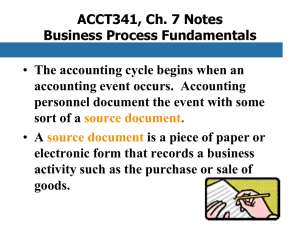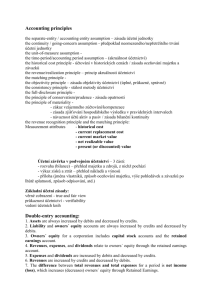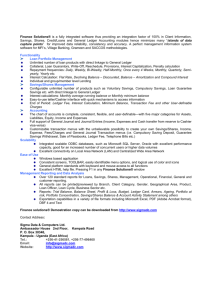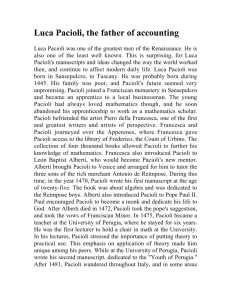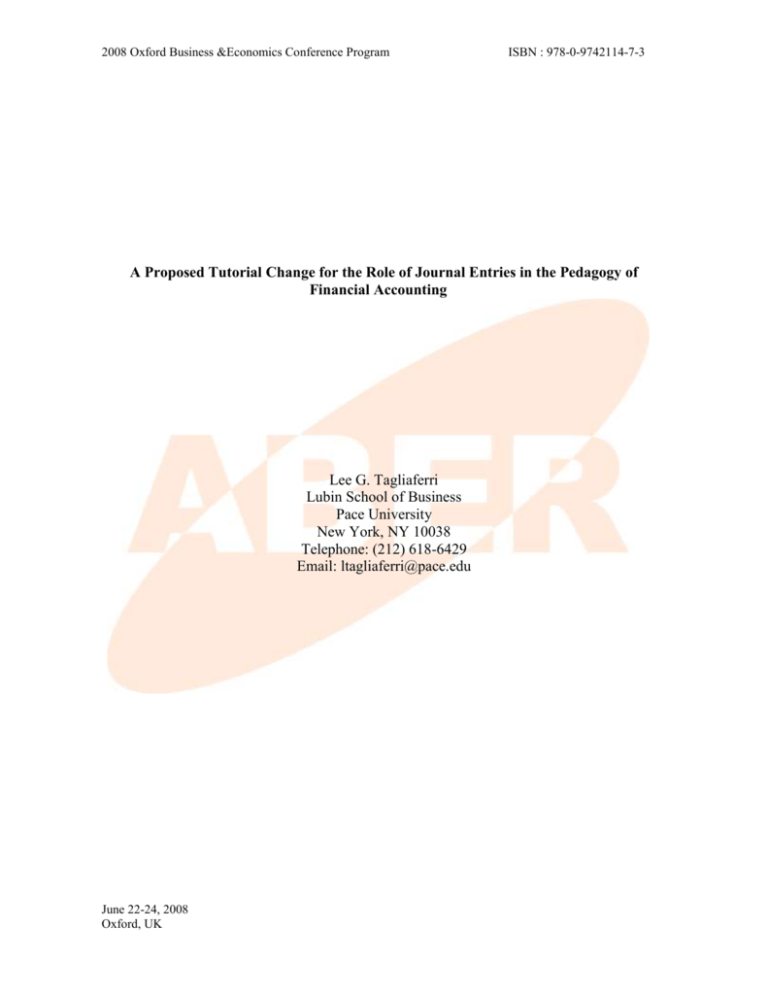
2008 Oxford Business &Economics Conference Program
ISBN : 978-0-9742114-7-3
A Proposed Tutorial Change for the Role of Journal Entries in the Pedagogy of
Financial Accounting
Lee G. Tagliaferri
Lubin School of Business
Pace University
New York, NY 10038
Telephone: (212) 618-6429
Email: ltagliaferri@pace.edu
June 22-24, 2008
Oxford, UK
2008 Oxford Business &Economics Conference Program
ISBN : 978-0-9742114-7-3
A Proposed Tutorial Change for the Role of Journal Entries in the Pedagogy of
Financial Accounting
ABSTRACT
In a previous study of Particularis de Computis et Scripturis (De Scripturis), the treatise of
Luca Pacioli, it was found that the terms debit and credit in the computer age are not
relevant to accounting pedagogy and practice. As an augmentation to the foregoing
investigation, the purpose of this study is to ascertain if, with the elimination of debits and
credits, journal entries continue to be pertinent in their duel role to teach, simultaneously,
accounting and bookkeeping for business transactions, as expounded by Lucia Pacioli in
his treatise. I find that journal entries can be bypassed in computer age pedagogy to instruct
processing data for posting to the ledger in bookkeeping and to teach how specific business
transactions change the balance sheet in accounting. In the treatise of Luca Pacioli, those
objectives of bookkeeping and accounting for individual transactions are accomplished by
incorporating manually prepared journal entries as a dual function didactic vehicle. The
computer now obviates the task of preparing journal entries manually. Instructions no
longer are required for posting to accounts in the ledger, which is the source of information
for the preparation of financial statements. I find that with the bypassing of the entry to
journals in computer data processing, a direct approach for posting to accounts in the ledger
can be substituted in the tutelage of bookkeeping for individual business transactions. I
find, also, that with the bypassing of the entry to journals in financial position change
analysis, a direct approach can be substituted in a balance sheet model in the tutelage of
accounting for individual business transactions. Based upon those findings, I suggest a
tutorial which bypasses the journal entry to teach bookkeeping and accounting for
June 22-24, 2008
Oxford, UK
2
2008 Oxford Business &Economics Conference Program
ISBN : 978-0-9742114-7-3
individual business transactions. I argue that this tutorial would simplify accounting and
bookkeeping in the pedagogy of Luca Pacioli and contemporary textbooks.
I. INTRODUCTION
In a previous study of De Scripturis, the treatise of Luca Pacioli, it was found that the terms
debit and credit in the computer age are not relevant to accounting pedagogy and practice
(Tagliaferri, 2007). The purpose of this study, as an augmentation to the foregoing
investigation, is to ascertain if, with the elimination of a debits and credits, journal entries
continue to be pertinent in their duel role as a vehicle to teach, simultaneously, accounting
and bookkeeping for business transactions, as expounded by Lucia Pacioli. The treatise of
Luca Pacioli, the first printed text on the subject of accounting and bookkeeping, is the
pedagogic source establishing journal entries with debits and credits. His text, written over
500 years ago, serves as a model for the tutelage of accounting principles and bookkeeping
techniques in contemporary textbooks. Pacioli’s text is the work of a genius and shows how
little bookkeeping has changed since his treatise was published in 1494 (Cripps, 1994).
The scope of my study is to examine the purpose of the invention of journal entries,
which were devised for manual bookkeeping in the treatise of Luca Pacioli, as translated by
Brown & Johnston (1963), Cripps (1994), and Crivilli (1924). In my study, I probed
whether or not the didactic role of journal entries would be pertinent if it is extended to
computerized data processing. In the pedagogy of Luca Pacioli, journal entries in data
processing are devised to teach bookkeeping and accounting at the same time for individual
June 22-24, 2008
Oxford, UK
3
2008 Oxford Business &Economics Conference Program
ISBN : 978-0-9742114-7-3
business transactions. Therefore, journal entries take on a dual role in the pedagogy of Luca
Pacioli. I examined the rationale of this dual role as it relates to the bookkeeping systems
of manual and computer data processing. I find that in modern computer data processing,
Luca Pacioli’s journal entries are no longer didactically relevant as a vehicle to teach data
processing in bookkeeping and balance sheet change analysis in accounting for individual
business transactions.
Luca Pacioli was a mathematician, acclaimed as the most brilliant in the Italian
Renaissance (Brown & Johhston, 1963). One of his major legacies is the introduction and
exposition of the accounting equation and corresponding double entry bookkeeping
postulate. He defined the balance sheet, or financial position, of a business entity. He
observed that when a business transaction takes place the change of one component of the
financial position must be offset by the change in at least one other in order for the
accounting equation to remain in balance. Based upon this fundamental accounting
principle, when recording a business transaction in bookkeeping a double entry in the
ledger must be made. The computer age does not change this fundamental of accounting
and bookkeeping introduced by Luca Pacioli. I find that this postulate does not influence
the dual function of the journal entry as a vehicle in teaching bookkeeping and accounting
for business transactions.
In my study I find that the journal entry was devised in the tutelage of Luca Pacioli for
the following objectives:
1. Provide information to post to accounts in the ledger.
June 22-24, 2008
Oxford, UK
4
2008 Oxford Business &Economics Conference Program
ISBN : 978-0-9742114-7-3
2. Establish a reference for the verification of transactions with source
documents and ledger postings.
3. Instruct the manual posting of specific business transactions to the ledger, the
source of information for the preparation of financial statements.
4. Teach how specific business transactions change the balance sheet, or
financial position, of a company.
In the first and second objectives, the journal in Luca Pacioli’s bookkeeping system is the
keystone to control the reliability and propriety of data processing. The journal is the book
of original entry of business transactions and is the source of data posted to the ledger. The
journal is, further, a reference to verify with support documents the authenticity of a
transaction entered and the reliability of the interpretation of how it changed the balance
sheet. As a center of reference, the journal verifies in the ledger the authenticity of a
transaction posted and the reliability of its data. I find that computer data processing does
not change the forgoing objectives of the journal in this ingenious system of bookkeeping
control devised in the treatise of Luca Pacioli.
I find that the journal entry in the computer age can be bypassed in the above third and
fourth objectives, respectively, of Luca Pacioli to instruct postings to the ledger in
bookkeeping and to teach transaction analysis in accounting.
The bookkeeping and
accounting tutelage for individual business transactions is the mainstay of the text of Luca
Pacioli and contemporary textbooks. Expeditiously, the journal entry is a catalyst for both
bookkeeping and accounting tutelage and takes on a dual function. In bookkeeping, the
journal entry directs detailed procedures for postings of debits and credits to the ledger. In
June 22-24, 2008
Oxford, UK
5
2008 Oxford Business &Economics Conference Program
ISBN : 978-0-9742114-7-3
accounting, the journal entry is a vehicle to teach, indirectly, how a business transaction
changes the balance sheet. The journal entry, at the same time, teaches bookkeeping and
accounting.
In contemporary bookkeeping, the computer is both the journal and ledger. In the
computer, entries to the journal are, simultaneously, posted to the ledger for a business
transaction. No bookkeeping instructions are required for automatic data processing. I find
that teaching entries to the journal separate from posting to the ledger in the computer, as in
Luca Pacioli’s manual bookkeeping, would be superfluous. I suggest, in contemporary
tutelage for bookkeeping, bypassing the journal entry as a vehicle in order to post data
directly to the ledger, which provides the information for the preparation of financial
statements. In this alternative, Luca Pacioli’s tutelage for bookkeeping is revised to teach
direct entries to the ledger with a plus or minus to each account, as in a computer
spreadsheet program. Entering data of transactions directly into the ledger, bypassing
didactic exhibits of the journal entry, in one step simplifies bookkeeping tutelage,
compared to the multiple steps mandated in the manual data processing of Luca Pacioli.
When eliminated as a didactic vehicle in bookkeeping procedures for individual business
transactions, the journal entry is reduced to a single purpose, which is teaching how
business transactions change the balance sheet in accounting tutelage. The expedient
bookkeeping and accounting dual objective of the journal entry for individual business
transactions is erased. Indirectly, the journal entry teaches how transactions change the
balance sheet, which is the analysis that precedes bookkeeping journal entries. I suggest
that this indirect be converted to a direct approach of transaction analysis by replacing the
June 22-24, 2008
Oxford, UK
6
2008 Oxford Business &Economics Conference Program
ISBN : 978-0-9742114-7-3
journal entry as a didactic vehicle with a balance sheet model which depicts financial
position changes. I argue that the transaction analysis directly in a balance sheet format is
easier to learn than indirectly in a journal entry exhibit.
I devised a computer age tutorial incorporating the foregoing suggestions to replace the
journal entry dual purpose in the treatise of Luca Pacioli for the bookkeeping and
accounting pedagogy of individual business transactions. My tutorial teaches transaction
analysis directly in the balance sheet model, thereby replacing the journal entry to perform
this indirect didactic function of accounting pedagogy. In the instruction of bookkeeping,
transactions are posted directly into the ledger of a computer, without first exhibiting an
entry to the journal. I argue that my suggested tutorial would simplify the pedagogy of
financial accounting, while transforming it into the contemporary computer age. My study
finds that the tutelage for individual business transactions in bookkeeping and accounting
constitutes the predominant focus of the treatise of Luca Pacioli, which is carried into
contemporary textbooks on financial accounting.
In a study of the pedagogy of Luca Pacioli, it was suggested that the journal and ledger be
reconfigured differently in their pertinence to computer bookkeeping (Tagliaferri, 2007).
The design of the reconfigured journal is centered on the tutelage of how business
transactions change the balance sheet, rather than on bookkeeping complexities of debits
and credits to detect human errors. The study discloses that Luca Pacioli, in his tutelage of
bookkeeping procedures, teaches a recording technique of debits and credits in order to
achieve the objective of maintaining the balance sheet equilibrium when preparing journal
entries and to control accuracy in posting data to the ledger. The debits and credits of
June 22-24, 2008
Oxford, UK
7
2008 Oxford Business &Economics Conference Program
ISBN : 978-0-9742114-7-3
journal entries in Luca Pacioli’s treatise provide instructions for the bookkeeper for manual
data processing. In computer data processing, it was found that the debits and credits in the
journal format are not pertinent to posting controls. The computer ledger does not require a
trial balance of debits and credits in order to detect posting errors. In the pedagogy and
practice of bookkeeping and accounting in the computer age, the terms debit and credit are
not relevant and are omitted in my tutorial.
The rest of this paper is organized as follows. Section II probes the double entry postulate
of Luca Pacioli and whether or not its effectuation requires a dual role of journal entries in
the tutelage of bookkeeping and accounting. Section III examines Luca Pacioli’s internal
system of source documents, journals and ledgers and whether or not those control
components mandate the integration of the dual role of the journal entry as a vehicle in
teaching bookkeeping and accounting for individual business transactions. Section IV
analyzes the objective of journal entries propounded by Luca Pacioli. Section V probes the
journal in computer data processing, Section VI probes the journal in accounting pedagogy,
Section VII sets forth a suggested tutorial for bookkeeping and accounting in the computer
age, and Section VIII concludes.
II. DOUBLE ENTRY AXIOM
June 22-24, 2008
Oxford, UK
8
2008 Oxford Business &Economics Conference Program
ISBN : 978-0-9742114-7-3
My findings in the chapters of the treatise of Luca Pacioli in the sections of this study
which follow are based upon the translations of De Scripturis by Brown & Johnston
(1963), Cripps (1994) and Crivilli (1924). The 26 page treatise of Luca Pacioli was part of
a much larger work of 300 pages onmathematics that is entitled Summa Arithmetica,
Geometra, Proportioni et Proportionalita (Cripps, 1994). The title of the manuscript.
Details of Accounting and Recording, of Luca Pacioli manifests that it was written for both
accountants and bookkeepers. As a mathematician, he introduced the equilibrium axiom of
accounting for the balance sheet. When a business transaction changes an item in the
financial position, this must be offset by the change of another in order to maintain
equilibrium in the balance sheet equation.
His mathematical logic pertains to his
accounting pedagogy to teach how transactions change the balance sheet equation and is
applied to bookkeeping in data processing. He was not the originator of this pedagogy,
which is based on the Venetian accounting system, but was the first to write it down
(Taylor, 1942). In this sense, he is called the “father of accounting” (Lee, Bishop, &
Parker, 1996).
The equilibrium axiom is pertinent to accounting, not bookkeeping. The axiom is the
foundation for transaction analysis in accounting for business transactions. The axiom
makes it clear that the study of accounting is the study of how business transactions change
the balance sheet. Next, Luca Pacioli translated his theory into bookkeeping practice as he
established the ledger, the source of information for the preparation of financial statements.
Luca Pacioli applies this postulate to bookkeeping, known as the double entry system.
Following the equilibrium axiom, an entry to the ledger must be made for each change that
June 22-24, 2008
Oxford, UK
9
2008 Oxford Business &Economics Conference Program
ISBN : 978-0-9742114-7-3
a business transaction makes to the balance sheet. Hence, a double entry in the ledger is
called for in bookkeeping if only two accounts are involved. The equilibrium concept, also,
applies when there are more than two items that change in the balance sheet equation.
Luca Pacioli states that a businessman must be good accountant (Cripps 1994). He also
states that the merchant needs good bookkeepers (Chatfield, 1974). Accordingly, Luca
Pacioli states that his treatise will serve the needs of a businessman to know balances in the
ledger after he determines how transactions change them in accounting and the needs of
bookkeepers to record the changes. The dual task of accounting and bookkeeping is
expounded side by side in the text of Luca Pacioli. He wrote that there are regular rules and
cannons necessary to each (Chatfield, 1974). Equilibrium of the balance sheet is carried out
in the orderly bookkeeping system he designed for data processing. This system is
effectuated with journal entries, which both depict the accounting change to the financial
position for a business transaction and instruct related bookkeeping postings to the ledger.
This orderly bookkeeping system comprises a cross referencing system of journal entries to
control the authenticity, reliability, and accuracy of postings to the ledger. The
aforementioned lays the foundation for present accounting literature. Only the modern
aspects related to data processing by computers has changed (Brown & Johnston, 1963). It
is this change that prompts my study of whether or not in the computer age journal entries
are now outdated in the tutelage of balance sheet analysis in accounting and ledgers entries
in bookkeeping.
III. THE JOURNAL FOR BOOKKEEPING CONTROL
June 22-24, 2008
Oxford, UK
10
2008 Oxford Business &Economics Conference Program
ISBN : 978-0-9742114-7-3
In chapters 5 through 8, Luca Pacioli prescribed in his text a data processing system
comprising interrelated books which control the authenticity, reliability, and accuracy of
account balances in the ledger. His system for the internal control of transactions entered
and processed in the records has remained unchanged and is the model for bookkeeping in
contemporary accounting textbooks. The system is focused on procedures for the control of
transactions processed. Hence, the internal control procedures of Luca Pacioli apply to
computer as well as manual data processing. In a scheme for data processing controls, the
bookkeeping system of Luca Pacioli comprises three books: memorandum, journal, and
ledger. All transactions are entered in each book with cross referencing to control data
processed from the memorandum to the journal and, ultimately, to the ledger. In the
memorandum, each transaction is first entered. It is supported by documentation, such as
sales or purchase agreements, giving evidence that the transaction took place. The terms
and conditions of the transaction are spelled out in detail, including, as in the case of sales,
for example, sales price, quantity sold, customer name, date, brokerage fees, name of bank
for a draft, cash received, cost of inventories sold, payment due date, and interest charges.
The transactions in the memorandum are entered chronologically. The pages are numbered
in order to prevent the fraudulent removal of transactions.
Each transaction is entered in the journal with cross referencing to the memorandum.
Reference to the memorandum is made to verify the accuracy of data entered in the journal.
The memorandum is, also, the source to verify that in the journal transactions entered are
authentic, none of them are omitted, and the change to the balance sheet is depicted
correctly. Today, in business, a file of source documents in hard copy form or
electronically in the computer substantiates the journal entry and replaces the
June 22-24, 2008
Oxford, UK
11
2008 Oxford Business &Economics Conference Program
ISBN : 978-0-9742114-7-3
memorandum. After preparation of the journal entry, data is transferred to the ledger. The
ledger is the ultimate destination of data for individual business transactions and the source
of information for financial statements. Cross referencing from the ledger to the journal can
detect fraudulent entries or omissions in the posting of transactions. This system of internal
control relates to data processing precautions, and its structure is the same for both a
computer generated and manually entered ledger.
IV. THE JOURNAL IN BOOKKEEPING TUTELAGE FOR SPECIFIC BUSINESS
TRANSACTIONS
Chapters 13 through 22 of the treatise of Luca Pacioli instruct bookkeeping procedures
to follow for entering data in the ledger. In chapters 18 to 22, in particular, of the treatise of
Luca Pacioli, the journal entries give instruction to post debits and credits to the specific
accounts in the ledger. For each business transaction, debits and credits are posted to ledger
accounts as directed by journal entries. Instructions are given in the treatise for uniform
formatting of data entries and cross referencing for posting controls. A unique system of
posting debits and credits to ledger accounts is installed in order to ascertain at any time if
assets equal liabilities plus capital. Debits are entered on the left hand side of the page and
credits on the right hand side. The balance sheet is in equilibrium when debits equal credits.
The listing of debits and credits is carried out in the trial balance. The technique of listing
debits and credits separately in each ledger account has another advantage. If because of an
incorrect manual posting there is an error in the trial balance, the debits and credits in the
ledger can be referenced expeditiously to those in the journal.
June 22-24, 2008
Oxford, UK
12
2008 Oxford Business &Economics Conference Program
ISBN : 978-0-9742114-7-3
The ultimate objective of data processing is to post changes which business transactions
bring about to accounts in the ledger, inasmuch as this record is the source of information
for financial statements.
The journal entries, by instructing postings to the ledger,
accomplish this objective in the manual data processing of Luca Pacioli. When debits do
not equal credits in the trial balance, bookkeepers fall back on the journal entry as a point
of reference to pick up errors in Luca Pacioli’s system of data processing controls.
V. THE JOURNAL IN COMPUTER DATA PROCESSING
In my study, I probed whether or not, as in manual bookkeeping, the instructional role of
journal entries to post to the ledger individual business transactions is pertinent to
computerized data processing. Computer data processing for entries to the ledger is not
faced with the problem of errors in the equilibrium of the accounts, as found in manual
bookkeeping. Debits and credits are non-existent in electronic bookkeeping. There is no
trial balance listing debits and credits. Rather, the total value of a listing of the asset
accounts will always equal the total for liabilities plus capital. To classify increases and
decreases to assets as debits and credits, respectively, is not relevant to bookkeeping by the
computer, inasmuch as it has no is no trial balance listing debits and credits.
The previous study of debits and credits (Tagliaferri, 2007) suggested that in the journal
entries of Luca Pacioli the vocabulary debit assets and credit liabilities and capital be
replaced by the terms increase assets and increase liabilities and capital, respectively.
Conversely, this would apply to decreases in assets, liabilities, and capital. The complexity
June 22-24, 2008
Oxford, UK
13
2008 Oxford Business &Economics Conference Program
ISBN : 978-0-9742114-7-3
of debits and credits which can both increase and decrease accounts in the ledger would be
eliminated. In the tutelage of bookkeeping, a revised journal format to conform to computer
data processing would depict more clearly than at present how a business transaction
changes the financial position. It was argued that this clarification would make the subject
of accounting easier to learn and relevant to data processing technology in the computer,
compared to contemporary pedagogy.
In data processing by the computer, entries, to its journal are, simultaneously, entered in
its ledger for a specific business transaction. There are no instructions required for a
bookkeeper, contrary to the manual procedures of Luca Pacioli, to post data to the ledger
from the journal. Accordingly, in the computer the journal entry can be bypassed in
teaching postings to the ledger. The entry of data to the computer journal for a transaction
is tantamount to an entry of data to the ledger, inasmuch as both take place simultaneously.
It is the ultimate objective of both manual and computer bookkeeping to enter changes to
the balance sheet equation brought about by business transactions into accounts in the
ledger. In manual bookkeeping, the journal entry is a conduit to instruct postings to the
ledger. In the computer, the journal entry does not serve the purpose of giving instructions
to the bookkeeper for postings to accounts in the ledger. Therefore, the journal as a conduit
to instruct postings can be bypassed in the bookkeeping tutelage of computers with a direct
entry to the ledger. This compares with the manual indirect bookkeeping procedure which
requires instructions from the conduit of a journal entry in order to post data to the ledger.
In the computer, the journal takes on a specialized format. Essentially it portrays the
amount of increase or decrease for the accounts which will change when a business
transaction is posted to the computer ledger. My investigation of the function of journals in
June 22-24, 2008
Oxford, UK
14
2008 Oxford Business &Economics Conference Program
ISBN : 978-0-9742114-7-3
bookkeeping suggests that in the computer age they be bypassed with entries made directly
in the ledger in bookkeeping tutelage. I argue that direct postings to the ledger, bypassing
the journal entry, combined with the elimination of debits and credits, would make the
pedagogy of bookkeeping easier to learn, compared to the manual data processing
pedagogy of contemporary textbooks. In bookkeeping tutelage for individual business
transactions, bypassing the journal entry does not diminish its invaluable function as a book
of original entry in the data processing control system of Luca Pacioli. The internal control
system of cross referencing the journal with source documrnts and the ledger apply to boh
manual and computer bookkeeping.
VI. THE JOURNAL IN THE ACCOUNTING TUTELAGE FOR SPECIFIC
BUSINESS TRANSACTIONS
Luca Pacioli defined the balance sheet in Chapter 12 of his treatise when he entered the
assets in the journal at the inception of a business entity. He did not articulate with
discourse how the balance sheet changed when entries were made in the journal. The
debits and credits in the journal were self-explanatory for the accounting analysis of the
effect of business transactions on the balance sheet equation. This approach in accounting
tutelage with journal entries continues to be the didactic technique of teaching,
concurrently, how a business transaction changes the financial position in accounting and
data processing in bookkeeping. In Chapter 12, assets are entered, initially, in the journal as
debits and offset by capital as credits.
In his pedagogy, capital increased as assets
increased.
June 22-24, 2008
Oxford, UK
15
2008 Oxford Business &Economics Conference Program
ISBN : 978-0-9742114-7-3
Luca Pacioli, after defining the balance sheet at the inception of the firm, teaches
transaction analysis in accounting with debits and credits in journal entries. The journal
entries depict how individual business transactions change the balance sheet under specific
circumstances in chapters 18 through 23, as follows.
In the purchase of materials transactions, asset inventories increase (debit). This is
offset by asset cash decreasing (credit) or liability payable increasing (credit). Both
accounts payable and notes payable comprise liabilities. Brokers’ fees are classified
as an increase to the cost of inventories (debit).
In sales transactions, assets accounts receivable, notes receivable, and drafts
increase (debit) and asset inventories at cost decrease (credit). The difference is
entered directly in the ledger to the profit and loss account to be closed to capital
after income is calculated.
A borrowing from the bank increases asset cash (debit) and increases liability notes
payable (credit).
When purchases on credit are paid, asset cash decreases (credit) and liability
accounts payable or notes payable decreases (debit).
When collections from customers to whom merchandise was sold on credit take
place, asset cash increases (debit) and asset accounts receivable or notes receivable
decreases (credit).
When sales commissions are paid or are to be paid to a broker, asset cash decreases
or accounts payable increases (credit) and profit and loss, a nominal capital account,
decreases (debt).
June 22-24, 2008
Oxford, UK
16
2008 Oxford Business &Economics Conference Program
ISBN : 978-0-9742114-7-3
When operating expenses are incurred, asset cash decreases ( credit) and capital
decreases in a nominal expense account (debit)
For a partnership entity, separate capital accounts are established for each owner.
The nominal capital accounts, profit and loss and expenses, provide information for
the income statement, which shows how much capital changed for a particular
interim of time. Periodically, after an income statement is prepared, the nominal
accounts are closed to Capital.
Luca Pacioli’s forgoing tutelage explains in journal entries the change to the balance
sheet caused by business transactions at the same time as teaching bookkeeping postings to
the ledger. Hence, the journal entry in the treatise takes on a dual task of teaching
accounting for transaction analysis and bookkeeping for entering changes to the accounts in
the ledger. The journal entries serve, expediently, Luca Pacioli’s dual objective of
bookkeeping instructions and accounting pedagogy explaining how individual categories of
business transactions impact the balance sheet. For specific business transactions in the
tutelage of Luca Pacioli, there is a clear demarcation between the pedagogy of accounting,
which encompasses transaction analysis and bookkeeping proceduresm which encompasses
data processing. However, he gave the same journal entries for both accounting and
bookkeeping.
In the previous Section V of this paper on bookkeeping tutelage, I suggested that business
transactions be entered directly in the computer ledger, bypassing the journal entry. This
obviates the expediency for a dual purpose of the journal entry. When eliminated as a
didactic vehicle in bookkeeping procedures, the journal entry is reduced to a single
June 22-24, 2008
Oxford, UK
17
2008 Oxford Business &Economics Conference Program
ISBN : 978-0-9742114-7-3
purpose, which is teaching how business transactions change the balance sheet in
accounting tutelage. The expedient bookkeeping and accounting dual objective of the
journal entry for individual business transactions is erased. Then, the journal entry, with a
single purpose, indirectly, teaches how transactions change the balance sheet. This
transaction analysis of Luca Pacioli precedes the preparation of
journal entries for
bookkeeping. I suggest that this single purpose indirect technique of transaction analysis
with a journal entry be converted to a direct approach in the tutelage of accounting. This
can be accomplished by replacing the journal entry as a didactic vehicle with a balance
sheet model to depict financial position changes. I argue that the transaction analysis
directly in a balance sheet format is easier to learn than indirectly in a journal entry with
debits and credits.
VII. SUGGESTED TUTELAGE FOR ACCOUNTING AND BOOKKEEPING
My study finds that the tutelage for individual business transactions in bookkeeping and
accounting constitutes the predominant focus of the treatise of Luca Pacioli, which is
carried into contemporary textbooks on financial accounting. I devised a computer age
tutorial incorporating my suggestions to replace the dual purpose journal entry with debits
and credits found in the treatise of Luca Pacioli and contemporary textbooks for the
bookkeeping and accounting pedagogy of individual business transactions. My tutorial
teaches transaction analysis directly in the balance sheet model, thereby replacing the
journal entry with debits and credits to perform this indirect didactic function of accounting
pedagogy. In the instruction of bookkeeping, transactions are posted directly into the ledger
June 22-24, 2008
Oxford, UK
18
2008 Oxford Business &Economics Conference Program
ISBN : 978-0-9742114-7-3
of a computer, without first exhibiting an entry to the journal. I argue that my suggested
tutorial would simplify the pedagogy of financial accounting, while transforming it into the
contemporary computer age.
The tutorial I suggest for balance sheet analysis in accounting and ledger entries in
bookkeeping to replace the dual role of journal entries for business transactions is
organized as follows in a simulated illustration. The illustration, a practical application of
business transactions in accounting and bookkeeping tutelage, comprises the following:
Individual business transactions are specified.
Transaction analysis for each of the above transactions is exhibited in a balance
sheet format.
Each of the above transactions is posted to the computer General Ledger, which
appears at the end of the simulation.
The business transactions demonstrated in the simulation which follows are for the first
month of a newly formed corporation. .
Transaction 1 - Investment was made by stockholders.
Transaction 2 - Equipment is purchased on credit.
Transaction 1
______________BS______________
Assets
Liabilities
Transaction 2
__________BS____
Assets
Cash + 2,000,000
Equipment + 240,000
SE
CC +2,000,000
RE
Liabilities
Notes Payable +240,000
SE
CC
RE
Transaction 3 - Inventories were purchased on credit...
June 22-24, 2008
Oxford, UK
_____________
19
2008 Oxford Business &Economics Conference Program
ISBN : 978-0-9742114-7-3
Transaction 4 - Creditors were paid.
Transaction 3
______________BS______________
Assets
Liabilities
Inventories + 500,000
Transaction 4
______________BS_____________
Assets
Liabilities
C ash – 500,000
Accounts Payable + 500,000
Accounts Payable-500,000
SE
SE
CC
RE
CC
RE
Transaction 5 - Insurance was purchased on credit.
Transaction 5
__________________BS___________________
Assets
Liabilities
Prepaid Insurance + 12,000
Accounts Payable + 12,000
SE
CC
RE
Transaction 6 - Merchandise was sold to customers.
Transaction 6
__________________B.S.___________________
Assets
Liabilities
Accounts Receivable + 300,000
Inventories - 100,000
SE
CC
RE + 300,000 Sales
-100,000 Cost of Goods Sold
Transaction 7 - Cash was collected from customers.
Transaction 7
__________________B.S.___________________
Assets
Liabilities
Cash + 50,000
Accounts Receivable – 50,000
SE
CC
Transaction 8 - An invoice was received from landlord.
Transaction 9 - A liability was accrued for salaries payable at the end of the work period.
Transaction 8
Transaction 9
______________BS______________
Assets
______________BS_____________
Liabilities
Assets
Liabilities
Accounts Payable + 20,000
Accounts Payable+40,000
SE
CC
RE – 20,000 Rent Expense
SE
CC
RE – 40,000 Salaries
Expense
Transaction 10 - The liability for rent was paid.
Transaction 11 - The liability for salaries was paid.
June 22-24, 2008
Oxford, UK
20
2008 Oxford Business &Economics Conference Program
Transaction 10
______________BS______________
Assets
Liabilities
Cash – 20,000
ISBN : 978-0-9742114-7-3
Transaction 11
______________BS_____________
Assets
Liabilities
Accounts Payable – 20,000
Cash – 40,000
Accounts Payable -40,000
SE
SE
CC
RE
CC
RE
Transaction 12 - A cash dividend was declared and paid in one transaction.
__________________B.S.___________________
Assets
Liabilities
Cash – 5,000
SE
CC
RE - 5,000
Transaction 13 – Month end adjustment for Prepaid Insurance.
__________________B.S.___________________
Assets
Liabilities
Prepaid Insurance – 1,000
SE
CC
RE - 1,000 Insurance expense
Transaction 14 – Month end adjustment for Office Equipment depreciation.
__________________B.S.___________________
Assets
Liabilities
Office Equipment -2,000
SE
CC
RE – 2,000 Depreciation Expense
Transaction 15 – Month end adjustment for Bad Debt expense.
__________________B.S.___________________
Assets
Liabilities
Accounts Receivable – 10,000
SE
CC
RE - 10,000 Bad Debt Expense
Transaction 16 – Month end adjustment for Interest expense accrued.
__________________B.S.___________________
Assets
Liabilities
Interest Payable + 2,400
June 22-24, 2008
Oxford, UK
21
2008 Oxford Business &Economics Conference Program
ISBN : 978-0-9742114-7-3
SE
CC
RE – 2,400 Interest Expense
General Ledger and Financial Statements at the End of All Transactions
G E N E R A L L E D G E R
ASSETS
Trans/Date
Cash
1-Mar 01
2,000,000
Acct's
Rec
Prepaid
Ins
LIABILITIES
Inventories
240,000
3-Mar 05
Explanation
300,000
Sales
-100,000
CGS
-500,000
12,000
12,000
300,000
6- Mar 8-31
-100,000
50,000
RE
500,000
-500,000
6- Mar 8-31
Cont.Cap
240,000
500,000
5-Mar 06
7- Mar 9-31
Acct's Pay
2,000,000
2-Mar 01
4-Mar 06
Equipment
S.E.
Notes
Pay
-50,000
8-Mar 15
20,000
-20,000
Rent Exp
9-Mar 15
40,000
-40,000
Salaries Exp
10-Mar 16
-20,000
-20,000
11-Mar 16
-40,000
-40,000
12-Mar 21
-5,000
13-Mar 31
-1,000
14-Mar 31
-2,000
15-Mar 31
-10,000
2,400
1,485,000
240,000
Dividends
-1,000
Insurance Exp
-2,000
Depreciation Exp
-10,000
16-Mar 31
Balance
-5,000
11,000
400,000
238,000
14,400
-2,400
240,000
2,000,000
Bad Debt Exp
Interest Exp
119,600
VIII. CONCLUSIONS
Journal entries were adopted by Luca Pacioli as a conduit with the objective to teach,
expeditiously, bookkeeping and accounting at the same time for individual business
transactions. The journal entries serve to explain how the balance sheet changes for a
business transaction, which is accounting tutelage, and manual posting to the ledger, which
is bookkeeping tutelage. Hence, journal entries in the pedagogy of
June 22-24, 2008
Oxford, UK
22
accounting and
2008 Oxford Business &Economics Conference Program
ISBN : 978-0-9742114-7-3
bookkeeping serve a dual purpose. In the contemporary computer age, the journal entry can
be eliminated in the accounting and bookkeeping tutelage for individual business
transactions. The computer automatically posts entries of the journal to the ledger. The
journal is no longer a tool to teach, indirectly, postings to the letter and can be bypassed.
Compared to the data processing of Luca Pacioli, direct posting to the ledger is a simplified
alternative for bookkeeping tutelage. The alternative is further simplified because the
computer ledger eliminates the complexity of debits and credits. In bookkeeping, bypassing
the journal entry of eliminates the expedient exigency of its dual didactic function.
Singularly, to teach transaction analysis, indirectly with a journal entry is irrational.
Transaction analysis directly in a balance sheet model is more translucent than the indirect
approach of the journal entry. I argue that the revised tutelage I suggest which bypasses
journal entries combined with the absence of debits and credits in the computer ledger
would make the subject of accounting easier to learn than the pedagogy in contemporary
textbooks.
REFERENCES
Brown, R. G., & Johnston, K. S. (1963). Paciolo on Accounting.
McGraw-Hill
New York, NY:
Chatfield, M. (1974). A History of Accounting Thought. Hinsdale, IL: Dryden Press.
Cripps, J. (1994) Particularis de Computis et Scriptures a Contemporary Interpretation.
Seattle, WA: Pacioli Society, Seattle Unoversity.
Crivelli, P. (1924). An Original Translation of the Treatise on Double-Entry BookKeeping. London, UK: The Institute of Book-Keepers, Ltd.
June 22-24, 2008
Oxford, UK
23
2008 Oxford Business &Economics Conference Program
ISBN : 978-0-9742114-7-3
Horngren, C. T., Sunden, G. L., Elliott, J. A., & Philbrick, D. R. (2006). Introduction to
Financial Accounting (9th ed). New York, NY: Pearson Prentice-Hall.
Lee, T. A., Bishop, A. & Parker, R. H. (1996). Accounting History from the Renaissance
to the Present. New York, NY: Garland Publishing, Inc.
Tagliaferri, L. (2007). “A Computer Age Revision for the Double Entry Treatise of Luca
Pacioli and Contemporary Accounting Textbooks,” 7th Global Conference on Business
and Economics Proceedings
Taylor, R. E. (1942). No Royal Road Luca Pacioli and His Times. Chapel Hill, NC:
University of North Carolina Press.
Ward J. (2005). Financial Accounting (3rd ed). New York, NY: McGraw-Hill Irwin.
June 22-24, 2008
Oxford, UK
24




